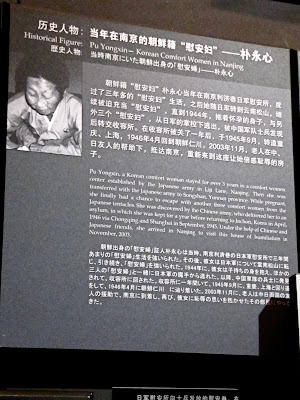**Warning, Graphic Images**
On the afternoon of our second day we found ourselves at the Nanjing Massacre Memorial Hall in Nanjing. This was a museum I had been looking forward to visiting and I was not disappointed. While I don't know a whole lot about Chinese history, I remember learning about the Rape of Nanjing in various history classes and books that I've read throughout the years. Right from the entrance I could see that it was going to be an interesting visit. We were greeted with numerous striking sculptures along the entryway into the museum.
The first room lists the names of victims of the Japanese attack that left over 300,000 civilians and unarmed soldiers dead after the siege of Nanjing.
The Japanese Imperial Army spared no one from their brutality as they entered the city. The Chinese army had blocked nearly every exit from the city, so the citizens of Nanjing had no where to run to. Men were rounded up, shot, bayoneted, bodies were mutilated and set on fire. Women of all ages were raped and gang raped, up to a thousand women every night. Many were killed and mutilated after they had been raped, some died from the rape itself.
Many photos are on display here from the massacre. Many photos were taken by Japanese soldiers. Others were taken by foreign journalists and residents of Nanjing. The photo below shows bodies lining the riverside.
Bodies were buried in mass graves. One site found years later is the site where they decided to build this memorial hall. The grave is open for the public to see. Photo below.
The foreigners who stayed on in Nanjing after the siege helped to save thousands of people. They set up a Safety Zone in one corner of the city. This corner was largely spared from bombings and served some protection from the Japanese soldiers. The leaders of the group of foreigners which formed this safety zone was a German clergyman who used his ties to the Nazi party to keep the Japanese out. As the Japanese and the Germans had some sort of pact of non-aggression they largely let the safety zone alone, though occasionally would round up some Chinese and take them out of the safety zone as they saw fit.
After the war, several top leaders of the Imperial Army faced military tribunal and were sentenced to death by hanging. The Royal Family of Japan who seemingly had a lot of influence in the military were granted immunity.
Incidentally, I found this tidbit about one of the "comfort women" who was brought from Korea to China to serve the Army's needs. The history of the Korean comfort women and the history rape of Nanjing are closely intertwined, and so I was happy to see that they recognized this part of history here at the memorial hall.
The Nanjing Massacre Memorial Hall is conveniently located on subway line number 2 at Jiangdongmen Station. It is also accessible by many buses. I highly recommend checking out this museum if you happen to find yourself in Nanjing. We spent about 2 hours here but we could have spent much more had our feet not been aching. If you are a history buff, you'll certainly want to give yourself a whole afternoon to really explore the place. There is so much to see, and there is a paragraph written for each photo and relic from the war. Admission is free and they are open from 8:30-16:30. Closed on Mondays.








No comments:
Post a Comment